Note: This article was the MASS Research Review cover story for July 2023 and is a review of a recent paper by Van Vossel et al. If you want more content like this, subscribe to MASS.
Key Points
- Researchers classified 95 novice trainees (38 women and 57 men) as having slow or fast twitch muscle fiber typology based on intramuscular carnosine levels. They examined the relationship between fiber typology and reps to failure on the leg extension, leg curl, biceps curl, and triceps extension exercises at a combination of relative intensities ranging from 40-80%.
- Subjects classified as fast twitch individuals performed significantly fewer reps to failure on the leg extension, leg curl, and biceps curl than slow twitch-classified individuals. However, the number of reps performed on the triceps extension was not significantly related to fiber typology.
- The presently reviewed study suggests that individuals with a greater proportion of type II fibers tend to perform fewer reps to failure on certain exercises. However, the correlations reported in this study were not very strong (all r ≤ 0.42); thus, it would be a stretch to say that reps to failure can predict fiber typology with high accuracy.
While some degree of scientific support can be found at times that one training style is superior to another, we also understand that rates of hypertrophy and strength gain are highly individual (2, 3, 4, 5). We also can say that, on average, individuals may perform about 10 reps to failure with a load corresponding to 75% of 1RM on the squat or bench press. However, substantial interindividual variation in reps performed at a given relative intensity (percentage of 1RM) exists. For example, recent data indicate that trained men and women performed a range of 6 – 28 repetitions on a squat set to failure at 70% of 1RM (6).
That individual variation sparks, what I believe, is the most pressing training question we face today: why does this individual variation exist? Regarding repetition performance, data have shown (6) that an individual’s body mass explains 20% of the variance in reps performed to failure at a given relative intensity, with heavier individuals completing fewer reps to failure. However, that leaves 80% of the variance unexplained. One popular suggestion to explain the remaining variance is that individuals with a higher proportion of type I fibers (slow twitch) have better muscular endurance than those with type II fibers. This suggestion makes sense, as type I fibers are more resistant to fatigue than type II fibers. A previous foray into this topic (7 – MASS Review) found that among 30 women and men, those with more type II fibers tended to perform fewer squat reps to failure at 80% of 1RM, but the correlation wasn’t that strong (rho = –0.38), leaving the conclusions tenuous. Thankfully, a new study from Van Vossel et al. (1) investigated the relationship between muscle typology and repetition performance at various relative intensities among 95 women and men.
Purpose and Hypotheses
Purpose
The reviewed study had three specific aims:
- To determine if maximal dynamic strength and isometric strength differed between individuals classified into slow and fast typologies.
- To examine the relationship between muscle typology and reps performed to failure on leg extensions, leg curls, biceps curls, and triceps extensions.
- To examine if various factors (relative intensity and strength level) influenced the number of reps to failure.
Hypotheses
The researchers hypothesized that individuals with a faster muscle typology (a greater proportion of type II fibers) would have greater max strength and perform fewer reps on various exercises (leg extension, leg curl, biceps curl, and triceps extension).
Subjects and Methods
Subjects
Ninety five women (n = 38) and men (n = 57) participated in the study. The researchers described the subjects as “resistance training novices who had never participated in a structured resistance training program.” Additional subject characteristics can be seen in Table 1.
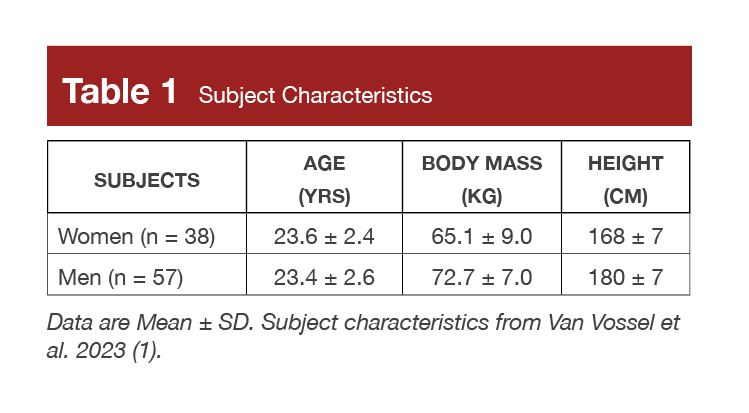
Pre-Testing for All Subjects
Before splitting subjects into groups, the researchers needed to determine muscle fiber typology. They did this via magnetic resonance spectroscopy, which identifies the chemical makeup of scanned tissue. In this case, the researchers examined the amount of carnosine in the scanned muscle. As you may recall, carnosine is a dipeptide of which beta-alanine is the rate-limiting precursor (i.e., to increase muscle carnosine effectively, you should take beta-alanine rather than carnosine itself). In addition to serving as a physiological buffer to delay fatigue, naturally occurring carnosine also indicates muscle fiber type. Specifically, higher amounts of carnosine are associated with more fast twitch (type II) fibers, while lower amounts of carnosine are associated with having more slow twitch (type I) fibers. Without getting into unnecessary specifics of the methodology, the researchers assessed fiber type through this technique for the vastus lateralis, gastrocnemius, and soleus and then estimated biceps, triceps, and hamstring typology from those muscles. Once fiber type was established, the researchers converted carnosine content to a z-score (more on this in the Criticisms and Statistical Musings section), and subjects were classified as fast twitch, intermediate twitch, or slow twitch. The researchers then assessed 1RM isometric leg extension torque for all subjects.
After these initial assessments for all 95 subjects, the researchers split the subjects into two groups to answer different research questions. One of the groups (the repetition group) contained a subgroup. Figure 1 provides a breakdown of group and subgroup structure; then, the following sections explain the specific procedures.
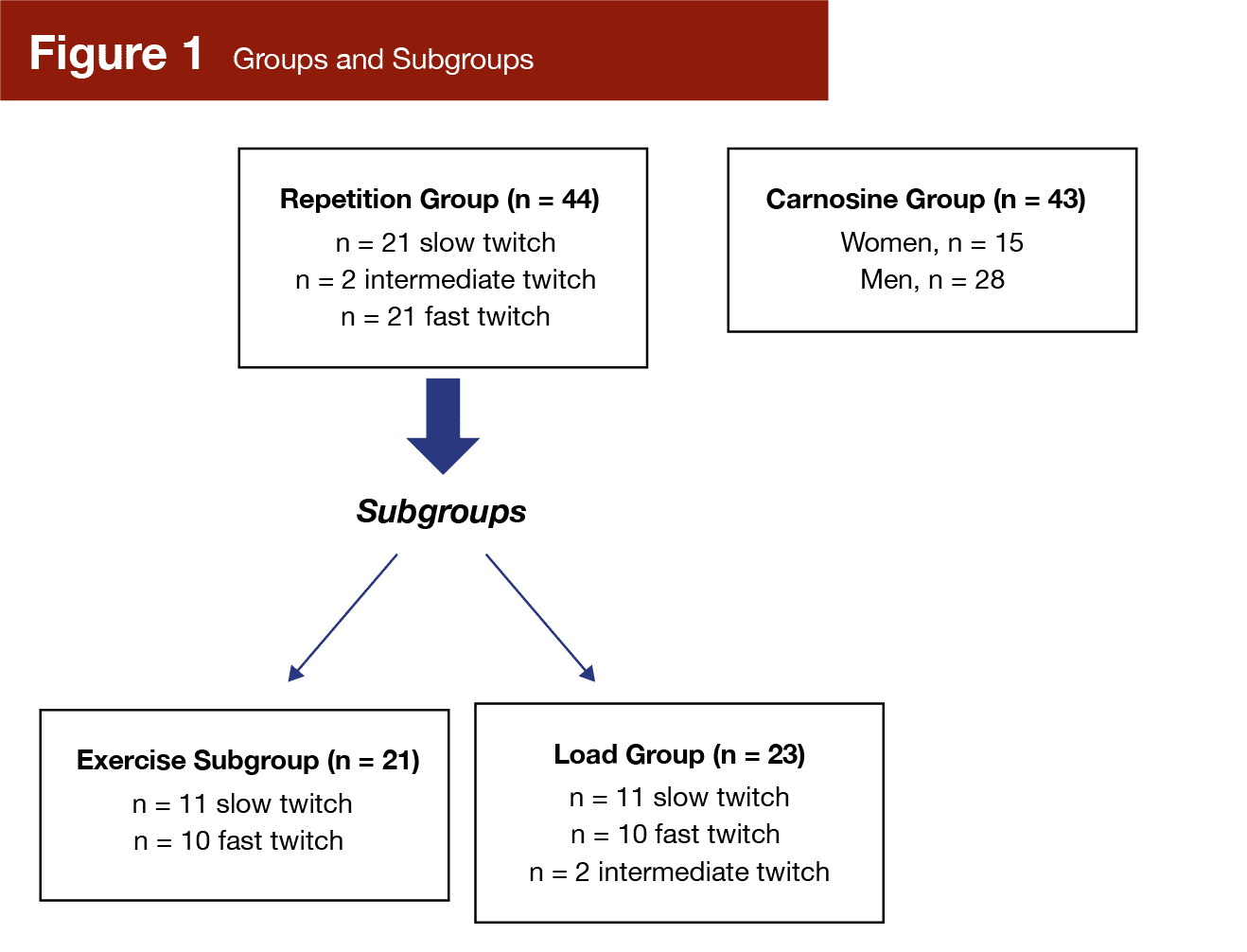
Repetition Group
In addition to testing leg extension isometric torque, all subjects in the repetition group also tested their dynamic 1RM on leg extensions, biceps curls, triceps extensions, and leg curls. Next, all individuals in the repetition group performed three sets to failure on leg extensions and biceps curls at 60% of 1RM. The exercise subgroup then performed additional sets to failure (the researchers did not specify how many) at 60% of 1RM on the same day, while the load subgroup performed three additional sets to failure at 80% of 1RM and additional sets to failure at 40% of 1RM over two more days.
Carnosine Group
Another 43 subjects, the carnosine group, performed only three sets to failure on leg extensions and curls following the initial assessments, but did not perform any dynamic 1RM testing.
Methods Summary and Outcomes
For clarity, Table 2 conveys each task done by each group or subgroup, and Table 3 lists the outcome measures assessed in each group or subgroup. Another note is that the researchers examined if upper leg fat-free mass (estimated from a scale), strength level, or body mass influenced the number of reps performed to failure.
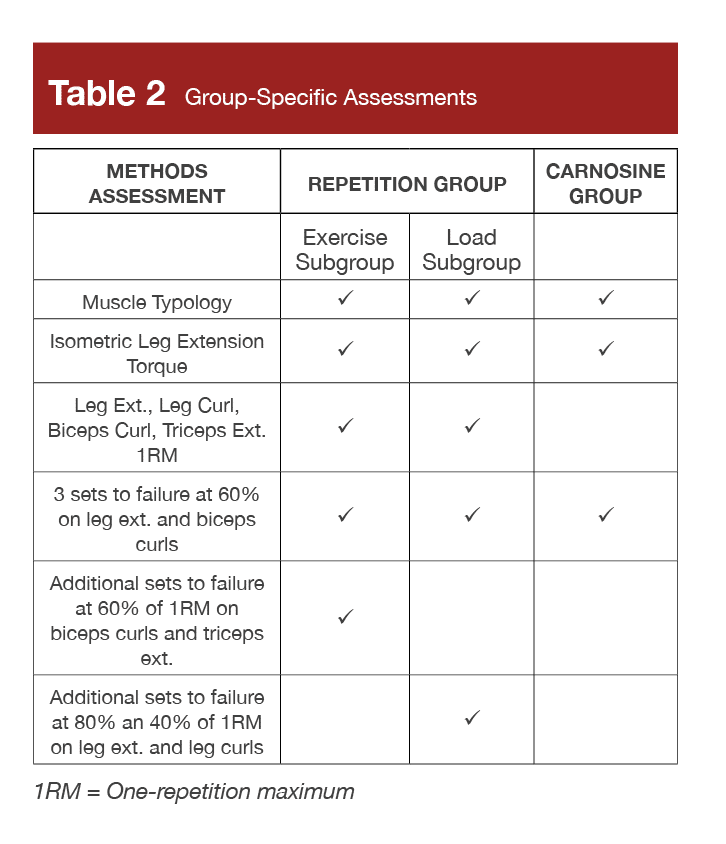
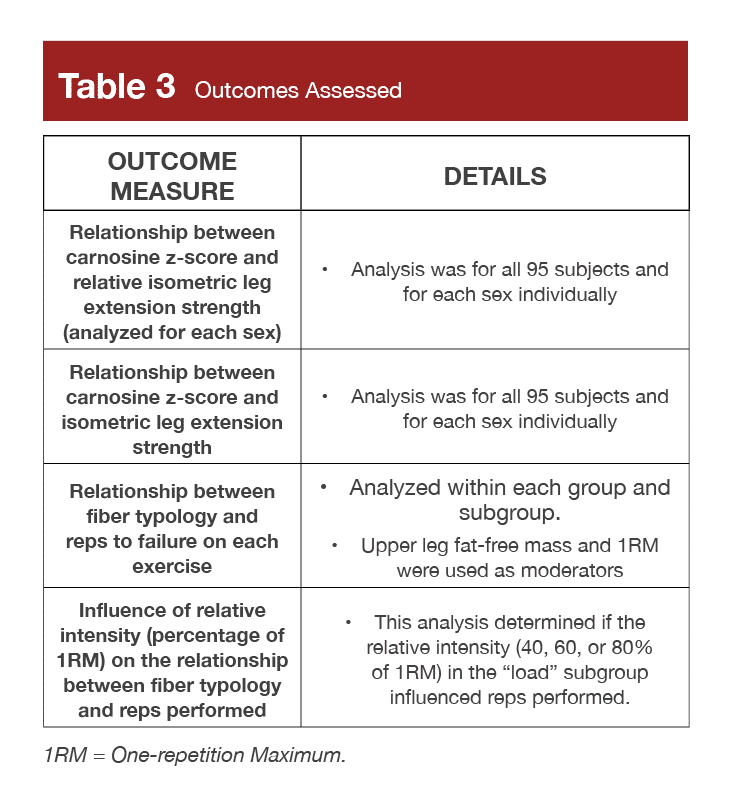
Findings
The main take home of the findings is that individuals classified as having fast twitch muscle fiber typology tended to perform fewer reps during sets to failure on the leg extension, leg curl, and biceps curls than individuals classified as having slow twitch fiber typology. Muscle fiber typology did not significantly influence reps performed on the triceps extension. Further details for all outcome measures are in the following subsections.
Relationship Between Typology and Isometric Strength
Across all subjects, there was a significant relationship between carnosine z-score and leg extension isometric torque (r = 0.30, p = 0.003) and relative torque (r = 0.22, p = 0.03), indicating that fast typology individuals could generate more force (i.e., were stronger). When broken down by sex, only men exhibited significant relationships between z-scores with both absolute (men: r = 0.37, p= 0.01; women: r = 0.19, p = 0.24) and relative (men: r = 0.26, p = 0.05; women: r = 0.16; p = 0.35) leg extension torque.
Relationship Between Typology and Reps Performed
Leg Extension and Leg Curls
Fast twitch individuals performed significantly fewer reps to failure than slow twitch individuals at 60% of 1RM on both the leg extension (p = 0.03) and leg curl (p = 0.01) (Figure 2). Further, there was a significant inverse relationship between carnosine z-score and reps performed to failure on leg extensions and leg curls (r = –0.44; p = 0.003), indicating that fast twitch typology individuals tended to perform fewer reps than slow twitch individuals. These findings were not significantly impacted by any covariate (upper leg fat-free mass, strength, or body mass). There was also no significant interaction by set, meaning that the rate of fatigue (decrease in reps performed from set to set) was not significantly different between fast and slow-twitch individuals. However, training load (40, 60, or 80% of 1RM) did impact reps performed in the load subgroup. Specifically, there were significant inverse relationships between carnosine z-score and reps performed at 60% (r = –0.41, p = 0.05) and 80% (r = –0.42, p = 0.04) of 1RM, but not at 40% (r = –0.23, p = 0.28). These findings indicate that fast twitch individuals tended to perform fewer reps than slow twitch individuals at 60 and 80% of 1RM but not at 40% of 1RM.
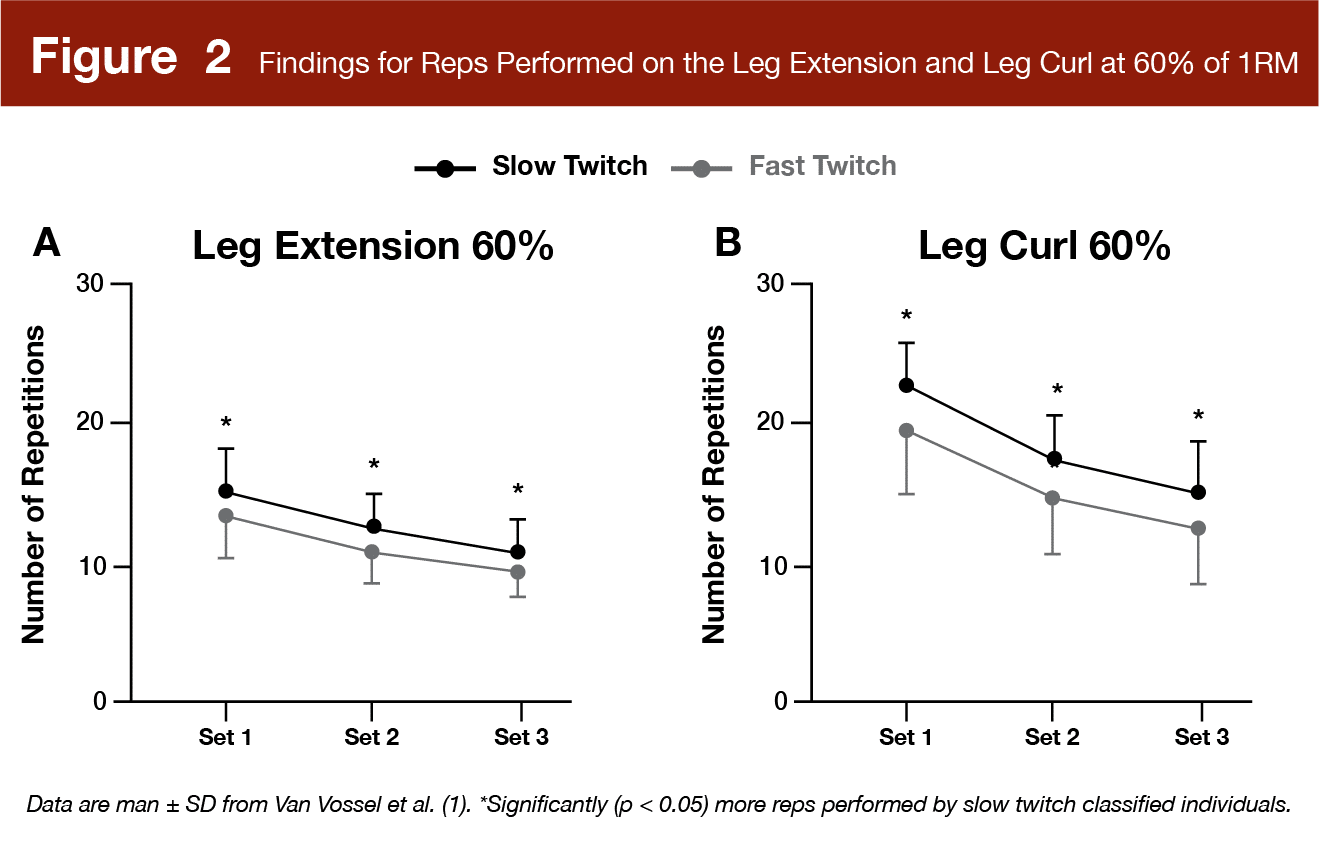
Biceps Curls and Triceps Extensions
Fast twitch individuals performed significantly fewer reps to failure at 60% of 1RM on the biceps curl (p = 0.02); however, there was no significant difference between groups for reps performed on the triceps extension (p = 0.96). Further, reps performed on either exercise were not significantly influenced by strength level or body mass (p > 0.05).
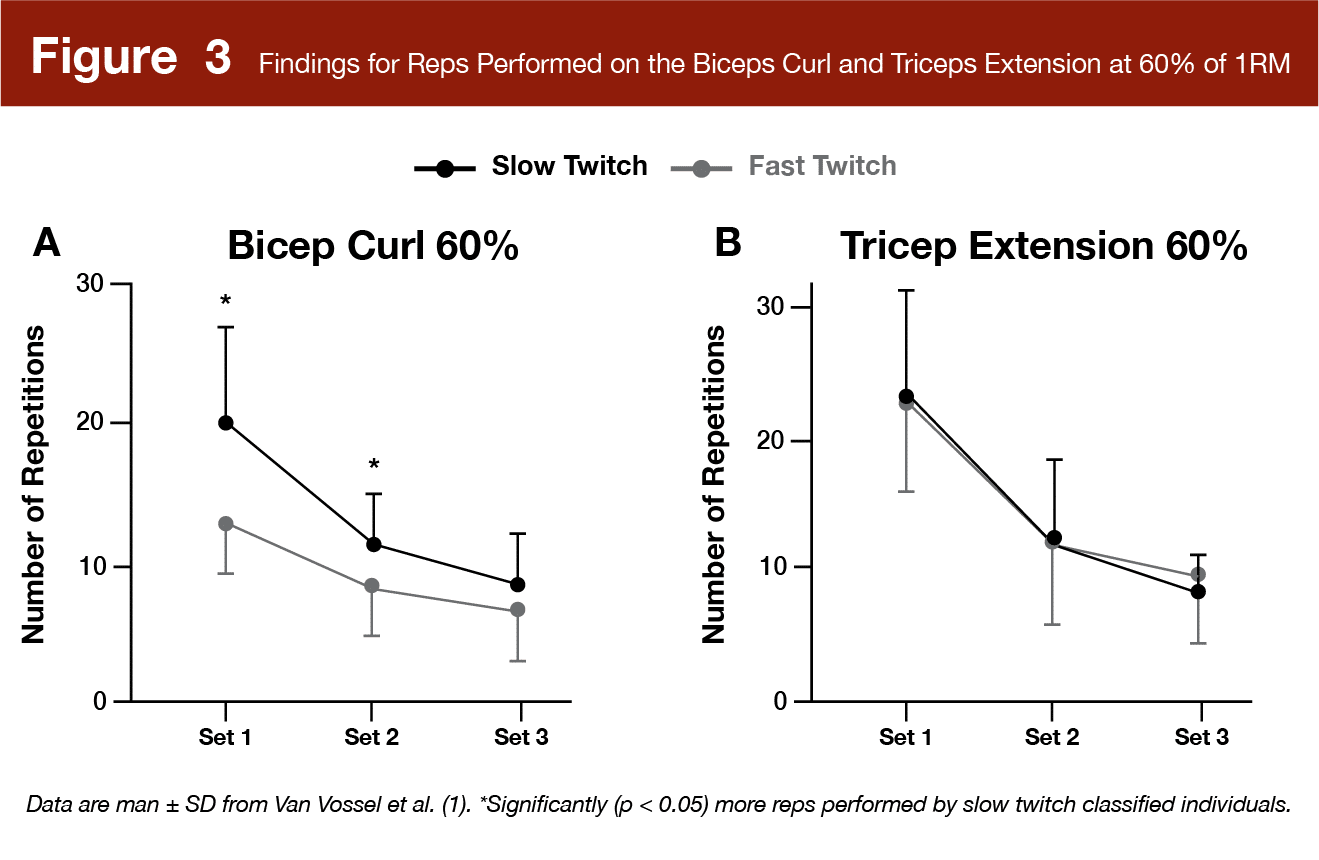
Variance in Reps Performed
Lastly, I want to highlight the range of reps performed, which was vast. For example, across three sets of the biceps curl at 60% of 1RM, a range of 18 – 62 reps was completed. The range of reps performed for all exercises with all three sets combined is in Table 4.
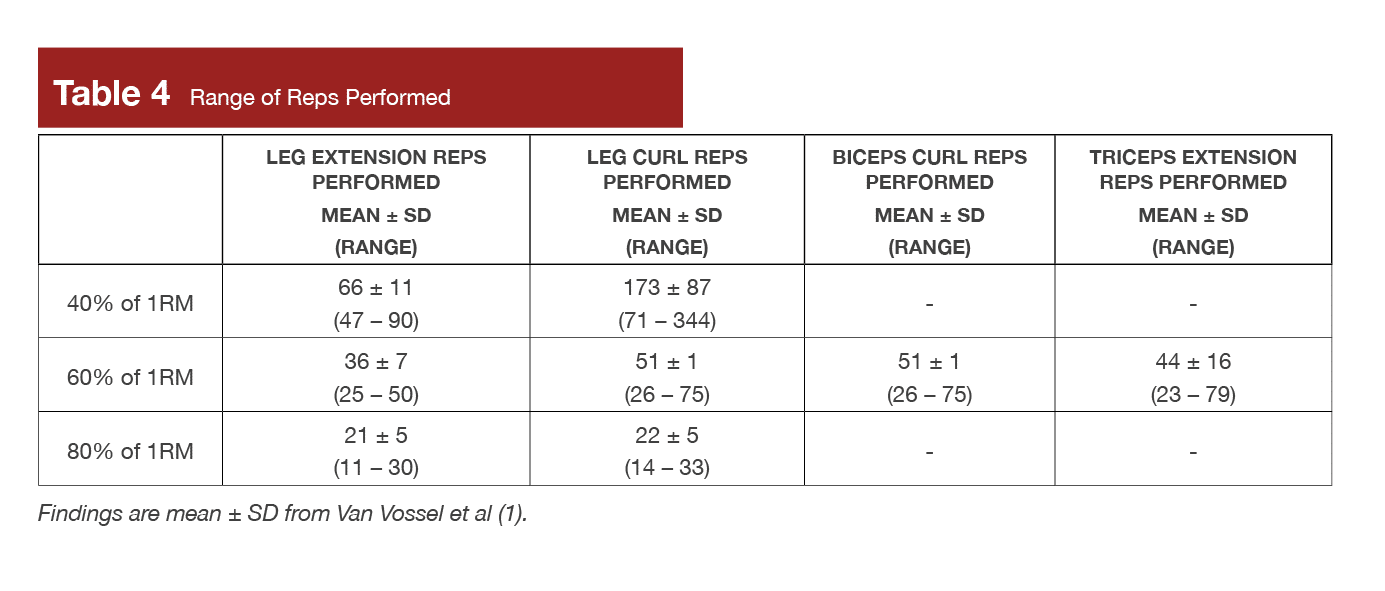
Criticisms and Statistical Musings
While not a criticism per se, this section explains the methods for those wanting a more complete understanding of how this study’s results were derived. A critical piece of the analysis in the presently reviewed study was classifying subjects as fast, slow, or intermediate twitch. To make this classification, a standardized “score” needed to be created to compare individuals to a reference value. In this study, the researchers had carnosine concentrations already established for a control population consisting of “active, healthy non-athlete” individuals for the gastrocnemius and soleus (women = 112; men = 163) and the vastus lateralis (women = 56; men = 70). Therefore, to classify individuals into high, intermediate, or slow twitch muscle fiber typologies, the researchers created a z-score for each individual’s carnosine concentration and compared that score to the mean score of the control dataset. A z-score is a standardized score that indicates the magnitude of standard deviations the metric differs from the mean of the entire dataset. In this study, the z-score was calculated as z = (observed value) – (mean of the control data set) / standard deviation of the control data set. Individuals were classified as slow twitch if they had a z-score of ≤ -0.5, intermediate twitch with a z-score between -0.5 to +0.5, and fast twitch with a z-score of ≥5.
Interpretation
As stated in this article’s introduction, I believe the most critical questions in contemporary training research are related to identifying the factors that explain inter-individual differences in training responses. For example, the rate of hypertrophy and strength is highly variable (2, 3, 4, 5); some individuals grow more with drop sets and some with traditional sets (6), and the number of reps performed to failure at a given relative intensity is also highly variable (6, 9, 10). Yet, we know very little about why the interindividual variance is so great. In the mid to late 2000s, data revealed that those with more satellite cells and myonuclei per myofiber tended to experience more muscle growth (5). More recently, researchers observed that individuals who grew more and gained more strength in response to higher volume training also tended to have greater levels of ribosomal biogenesis (i.e., increases in muscle ribosome content) (11). However, none of those findings are practical for the coach and lifter. In practice, coaches and lifters have to use trial and error to determine what training style someone responds best to. Therefore, research must attempt to examine practical strategies to explain individual variation.
Why Have a Practical Fiber Typology Assessment?
So, what’s practical about assessing fiber typology through an imaging technique? Well, nothing directly. However, if fiber typology can predict reps to failure, someone could do a set to failure and determine whether they are primarily fast or slow twitch. The next question is, why does determining if someone is a fast or slow twitch individual matter? Well, there is some evidence that having this information could impact programming decisions. For example, aside from knowing if a lifter has good muscular endurance, one study (12 – MASS Review) showed that individuals with a higher proportion of type II fibers took longer to recover from a maximal bout of cycling than those with type I fibers. The elongated recovery time could affect training frequency and training volume; thus, identifying fiber type classification could allow a lifter to manage their volume per session accordingly to ensure appropriate recovery. Other examples include the possibility that individuals classified as fast twitch may be more prone to overreaching (13 – MASS Review) and that low-load blood-flow restriction training may preferentially cause hypertrophy of type I fibers. I’m not sure any of the above examples are definitive. However, there’s enough research to suggest the possibility that a simple rep test to determine fiber typology could be practical and useful.
The Findings from Van Vossel et al. (1)
The presently reviewed study from Van Vossel et al (1) found that fast twitch individuals tended to perform fewer reps to failure at 60% of 1RM on the leg extension, leg curl, and biceps curl but not on the triceps extension than slow twitch individuals. Additionally, fast twitch individuals also performed significantly fewer reps to failure than slow twitch individuals at 80% of 1RM on the leg extension and leg curl; however, fiber typology did not significantly influence reps to failure at 40% of 1RM. There are two ways to interpret this data. On the one hand, someone could point to the somewhat tenuous relationships between fiber typology with leg extension (r = –0.41) and leg curl (r = –0.42) at 60% of 1RM and say that the r2-value was only about 0.20, which means fiber typology only explains 20% of the variance in reps performed. Someone could also say that the p-values for the relationship between typology and reps performed at 60% (p = 0.05) and 80% (p = 0.04) of 1RM on the leg extension and leg curl barely crossed the significance threshold. Additionally, Hall et al (7 – MASS Review) also reported correlations (Spearman correlations as opposed to Pearson) (rho = –0.38; p = 0.039) that barely crossed the significance threshold showing a greater proportion of type II fibers to be related to fewer reps to failure at 80% of 1RM on the squat in trained women and men. Moreover, another study from Douris et al (14) found that when fiber typology was estimated from a 55-rep fatigue test on a dynamometer, there was a significant relationship between reps performed and leg extension reps to failure at 70% of 1RM (r = –0.48; p = 0.02). Lastly, Terzis et al (15) found that active men with a slow twitch typology (fiber type composition >50%) performed only one more rep to failure, on average, on the leg press compared to fast twitch individuals, which was not a statistically significant difference. In other words, all of these findings barely cross the significance threshold, and one could conclude that those data aren’t solid enough to conclude that rep tests can be used to predict fiber typology.
On the other hand, someone could point to all the aforementioned studies (1, 7, 14, 15) and conclude that although the relationships aren’t particularly strong, they show a clear trend. The authors of the presently reviewed study, Hall et al (7) and Douris et al (14) all observed significant correlations showing that slow twitch-classified individuals performed more reps to failure at relative intensities between 60 – 80% of 1RM. Additionally, one could argue that even though the findings from Terzis et al weren’t significant, the one more rep, on average, in favor of slow twitch individuals follows the trend of the other studies. Further, Terzis et al (15) did find a significant relationship, and a fairly strong one (r = 0.70; p = 0.01) between capillaries per mm2 of muscle cross-sectional area, otherwise known as ‘capillary density” and reps to failure at 70% of 1RM on the leg press. An optimist would say that finding is important because type I fibers typically have far more capillaries than type II fibers (16), and capillaries have many mitochondria, aerobic enzymes, and lots of myoglobin (providing additional oxygen to the muscles), which all aid type I fibers’ fatigue resistance.
Although I’m cautiously optimistic, I take more of the latter view on this topic as I think these studies show a clear trend. I don’t think the data are strong enough to make all out predictions; however, if someone performs well above the mean (e.g., two standard deviations) for reps to failure, there is certainly enough data to suggest that their fiber typology may have something to do with it. However, the data are not robust enough to make specific claims such as “every rep above the mean is associated with 1% more type I fiber composition.” That type of claim would require a much more precise test with stronger correlations, and thus would be completely inappropriate. My advice is to take this data for what it’s worth – there’s probably something there, but it’s not yet definitive enough to drive training decisions.
It’s also worth noting that Van Vossel et al (1) did not find that slow twitch individuals performed more reps than fast twitch individuals on the lying triceps extension. The authors argue that one explanation for this is that the triceps are overwhelmingly composed of fast twitch fibers. Further, since researchers estimated triceps fiber typology from other muscles, it’s likely that triceps composition was different from other muscles and that all subjects had fast twitch dominant triceps. On the other hand, the gastrocnemius is about a 50/50 split between fast twitch and slow twitch, on average. Although the vastus lateralis tends to have more fast twitch muscle fibers, researchers have reported a large variation 13 – 18% for fiber type composition of the vastus lateralis. Therefore, reps to failure on some exercises may be affected by fiber typology more than others.
Moderators of Rep Performance and General Variance in Reps Performed
In the presently reviewed study, fiber typology accounts for approximately 20% of the variance in rep performance on the leg extension and leg curl, which means 80% of the variance was unexplained. Interestingly, the moderator’s sex, absolute strength, relative strength, and upper leg fat-free mass did not significantly affect reps to failure. The factor that moderated the relationship between typology and reps to failure was relative intensity (load lifted). Specifically, typology was related to reps performed at 60% and 80% of 1RM but not at 40% of 1RM.
Research failing to identify predictors of reps performed is fascinating, considering the large interindividual variation. For example, Table 4 in the Findings sections illustrates that over three sets to failure on the leg curl, the range of reps performed was 71 – 344 (40% of 1RM), 26 – 75 (60% of 1RM), and 14 – 33 reps (80% of 1RM). This phenomenon is present in many exercises, as shown in a foundational study from Hoeger et al (9) in both trained and untrained women and men, in a study in both resistance-trained and endurance-trained individuals from Richens and Cleather (10), and from Cooke et al (6) in a study on trained women and men. Cooke et al (6) not only found that trained women and men performed a range of 6 – 28 squat reps at 70% 1RM, but they also found in a multiple regression examining factors (body mass, body-fat %, femur length, age, and sex) influencing reps to failure that body mass was almost significant (p = 0.057). While intriguing, more research is needed to confirm the near-significant finding that those who weigh more tend to perform fewer reps to failure.
Additional Thoughts
One aspect of the findings I still need to address is the weak but statistically significant correlation (r = 0.22; p = 0.03) between isometric leg extension peak torque and fiber typology, indicating that fast twitch individuals tend to have greater isometric leg extension strength. However, fiber typology was not related to dynamic strength in any exercise. This finding is similar to Machek et al (17 – MASS Review), who found that among 12 powerlifters, there was no significant relationship between type II fibers and Wilks score.
Overall, many other factors (e.g., leverages, muscle size, etc.) influence repetition and strength capability over just fiber typology. However, fiber typology impacts recovery. Therefore, those with a greater proportion of type II fibers may need less volume and frequency to progress hypertrophy and strength than those with a greater proportion of type I fibers. That speculation is tenuous, but I bring it up to demonstrate the importance of identifying factors that can influence how to adjust training variables such as volume, intensity, and frequency. If research can make such practical assessments, coaches and lifters can begin to individualize training prescriptions without undergoing significant trial and error.
Next Steps
There are many directions this research could go. One path is to recruit lifters, assess fiber typology, then observe them all over the same training program and examine if typology was related to hypertrophy and strength gains. However, since assessing fiber type distributions isn’t practical, I’d like to see a study that assesses various practical measures at baseline (reps performed to failure, body composition, and limb lengths, among other practical metrics) and have these subjects complete a within-subjects design training study. In this proposed study, one limb could perform more frequently than the other. Theoretically, individuals who perform fewer reps to failure during pre-testing would potentially be fast twitch individuals and would need more recovery time and may benefit from less frequency. The same study could also be conducted but with volume between limbs manipulated instead of frequency. There are many options for what training variable to manipulate. Ultimately, as I said at the outset of this article, the concept of individualization is the most pressing question that research in our field needs to address, so hopefully, we see more in this area soon.
Application and Takeaways
- Van Vossel et al (1) found that individuals with a greater proportion of type II fibers tended to perform fewer reps to failure than slow twitch-classified individuals at 60% of 1RM on the leg extension, leg curl, and biceps curl. Fiber typology did not influence rep performance on the triceps extension.
- Similar to Van Vossel et al, other research has also reported weak but statistically significant relationships between fiber typology and rep performance.
- Despite the significant relationships between fiber typology and rep performance, the relationships aren’t strong enough for me to recommend that coaches and lifters can definitively predict fiber type by performing a set to failure.
Get more articles like this
This article was the cover story for the July 2023 issue of MASS Research Review. If you’d like to read the full, 100-page July issue (and dive into the MASS archives), you can subscribe to MASS here.
Subscribers get a new edition of MASS each month. Each issue includes research review articles, video presentations, and audio summaries. PDF issues are usually around 120 pages long.
References
- Vossel KV, Hardeel J, Van de Casteele F, de Jager S, Lievens E, Boone J, Derave W. Muscle typology influences the number of repetitions to failure during resistance training. European Journal of Sport Science. 2023 Apr 25(just-accepted):1-21.
- Hubal MJ, Gordish-Dressman HE, Thompson PD, Price TB, Hoffman EP, Angelopoulos TJ, Gordon PM, Moyna NM, Pescatello LS, Visich PS, Zoeller RF. Variability in muscle size and strength gain after unilateral resistance training. Medicine & science in sports & exercise. 2005 Jun 1;37(6):964-72.
- Klemp A, Dolan C, Quiles JM, Blanco R, Zoeller RF, Graves BS, Zourdos MC. Volume-equated high-and low-repetition daily undulating programming strategies produce similar hypertrophy and strength adaptations. Applied Physiology, Nutrition, and Metabolism. 2016;41(7):699-705.
- Erskine RM, Jones DA, Williams AG, Stewart CE, Degens H. Inter-individual variability in the adaptation of human muscle specific tension to progressive resistance training. European journal of applied physiology. 2010 Dec;110(6):1117-25.
- Petrella JK, Kim JS, Mayhew DL, Cross JM, Bamman MM. Potent myofiber hypertrophy during resistance training in humans is associated with satellite cell-mediated myonuclear addition: a cluster analysis. Journal of applied physiology. 2008 Jun 1.
- Cooke DM, Haischer MH, Carzoli JP, Bazyler CD, Johnson TK, Varieur R, Zoeller RF, Whitehurst M, Zourdos MC. Body mass and femur length are inversely related to repetitions performed in the back squat in well-trained lifters. The Journal of Strength & Conditioning Research. 2019 Mar 1;33(3):890-5.
- Hall EC, Lysenko EA, Semenova EA, Borisov OV, Andryushchenko ON, Andryushchenko LB, Vepkhvadze TF, Lednev EM, Zmijewski P, Popov DV, Generozov EV. Prediction of muscle fiber composition using multiple repetition testing. Biology of Sport. 2021 Jun;38(2):277-83.
- Angleri V, Ugrinowitsch C, Libardi CA. Individual Muscle Adaptations in different Resistance Training Systems in Well-Trained Men. International Journal of Sports Medicine. 2022 Jan;43(01):55-60.
- Hoeger WW, Hopkins DR, Barette SL, Hale DF. Relationship between repetitions and selected percentages of one repetition maximum: a comparison between untrained and trained males and females. The Journal of Strength & Conditioning Research. 1990 May 1;4(2):47-54.
- Richens B, Cleather DJ. The relationship between the number of repetitions performed at given intensities is different in endurance and strength trained athletes. Biology of sport. 2014 Jun 1;31(2):157-61.
- Hammarström D, Øfsteng S, Koll L, Hanestadhaugen M, Hollan I, Apro W, Whist JE, Blomstrand E, Rønnestad BR, Ellefsen S. Benefits of higher resistance‐training volume are related to ribosome biogenesis. The Journal of physiology. 2020 Feb;598(3):543-65.
- Lievens E, Klass M, Bex T, Derave W. Muscle fiber typology substantially influences time to recover from high-intensity exercise. Journal of applied physiology. 2020 Mar 1;128(3):648-59.
- Bellinger P, Desbrow B, Derave W, Lievens E, Irwin C, Sabapathy S, Kennedy B, Craven J, Pennell E, Rice H, Minahan C. Muscle fiber typology is associated with the incidence of overreaching in response to overload training. Journal of Applied Physiology. 2020 Oct 1;129(4):823-36.
- Douris PC, White BP, Cullen RR, Keltz WE, Meli J, Mondiello DM, Wenger D. The relationship between maximal repetition performance and muscle fiber type as estimated by noninvasive technique in the quadriceps of untrained women. The Journal of Strength & Conditioning Research. 2006 Aug 1;20(3):699-703.
- Terzis G, Spengos K, Manta P, Sarris N, Georgiadis G. Fiber type composition and capillary density in relation to submaximal number of repetitions in resistance exercise. The Journal of Strength & Conditioning Research. 2008 May 1;22(3):845-50.
- Andersen JL. Muscle fibre type adaptation in the elderly human muscle. Scandinavian journal of medicine & science in sports. 2003 Feb;13(1):40-7.
- Machek SB, Hwang PS, Cardaci TD, Wilburn DT, Bagley JR, Blake DT, Galpin AJ, Willoughby DS. Myosin heavy chain composition, creatine analogues, and the relationship of muscle creatine content and fast-twitch proportion to Wilks coefficient in powerlifters. The Journal of Strength & Conditioning Research. 2020 Nov 1;34(11):3022-30.




